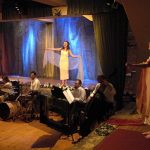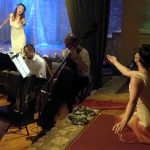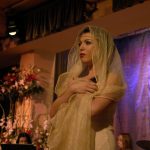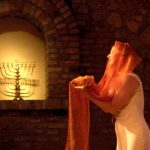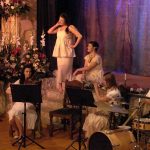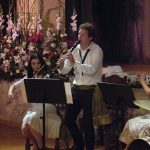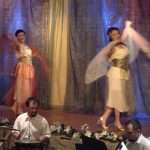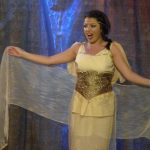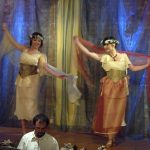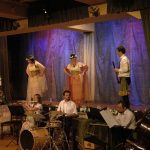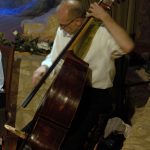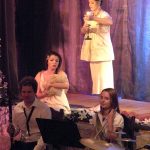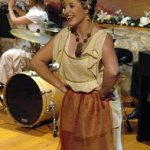Credits
Stage direction and choreoraphy: Jadwiga Leśniak-Jankowska
Arrangement, musical direction: Dawid Sulej Rudnicki
Scenography, costumes: Katarzyna Mucha
Linguistic consultation – Julia and Ula Makosz
Anna Bugajska – vocal
Wiktoria Węgrzyn – vocal
The Krakow Chamber Opera Orchestra
Violin – Karolina Bartczyszyn / Marta Rychlik
Flute – Ewa Tupik
Clarinet, soprano saxophone – Mariusz Stępień
Double bass – Lesław Wydrzyński
Percussion instruments– Grzegorz Fieber / Bartosz Sałdan
Keyboard instruments – Dawid Sulej Rudnicki
Photos
fot. Paweł Zechenter
Reviews
Das achtköpfige Ensemble aus Sängerinnen und Instrumentalisten präsentiert hier alte jüdische Volkslieder in jüdisch in neuen Arrangements, unterstützt von szenischem Spiel und Kulisse. Das Ergebnis ist ein Abend voller Genuss für Ohren und Augen auf höchstem künstlerischem Niveau.
Band of eight person – singers and musicians present here the old Jewish folk songs in jydish language in brand new arrangements with a stage movement and flower decoration. The effect is spending the evening with artistic impressions on the highest level which are the pleasure for the ears and eyes.
Heinrich Nowak
Germany, Rheingau
26th September 2016
* * * * * * * *
Chatskele, Chatskele! ist eine zauberhafter Abfolge von alten jiddischen Volksweisen, die mal szenisch, mal rein musikalisch präsentiert wurden (Regie und Choreografie: JADWIGA LEŚNIAK-JANKOWSKA). Zwei Sängerinnen (ANNA BUGAJSKA, WIKTORIA WĘGRZYN), die auch tanzend gute Figur machten, und ein 6-köpfiges Orchesterchen mit fabelhaftem improvisatorischem Können belebten die traditionelle Musik derart vital, dass das Publikum schier hingerissen war.
Chatskele, Chatskele! is a rich collection of old folk songs in Yiddish, which are performed interchangeably in scenic or solely musical form (direction and choreography: JADWIGA LEŚNIAK-JANKOWSKA). The two singers (ANNA BUGAJSKA, WIKTORIA WĘGRZYN), who enrich the performance also with their dancing, as well as the orchestra sextet with fantastic improvisational skills brighten up the music so much, that the audience is completely overwhelmed with it.
Karin Coper
Orpheus
September-October 2012
* * * * * * * *
LITERATURE IN THEATRE: PASSION OF EXISTENCE SUNG OUT ALOUD. “CHATSKELE, CHATSKELE”, MUSICAL SPECTACLE BASED ON OLD JEWISH SONGS
Stirring songs in Yiddish language: love and wedding compositions, lullabies and oneiric ballads used in “Chatskele, chatskele” gained a considerable popularity in Galicia before 1939. They were read, sung and played, yet they were never published in print in Poland. As I have read on the website of Krakow Chamber Opera, the director has seen its American version and decided to give a new life to those fascinating compositions. The spectacle is accompanied by precisely designed sequences of pictures: the performance includes not only Yiddish songs, but also the klezmer music and elements of traditional Jewish dances. The skill of the director is seen mostly in the discipline of its form, due to which what we see on stage is a refined and colourful spectacle. The show was particularly interesting for because of its successful extraction of its dramatic values. The spectator is overwhelmed not only by the musical tone, but also by the atmosphere of the story and the passion in the gestures. It is the naturalness and sensuality regained, the defence of life, the awe, joy and loneliness of devotion. The spiritual dimension of “Chatskele, chatskele” is determined by the captivating beauty of simplicity, elegance and proportion. Krakow Chamber Opera manages not only to survive, but also to remain what it was from the beginning – and, in addition, to prove its undeniable and unique position of the theatre that draws the connoisseurs of ambitious art.
Joanna Roś
bookeriada.pl
4th September 2012
* * * * * * * *
Love delicacy
Contemporary klezmer music, derived from the old temple music, has two completely different faces. One can be associated with commercial barnstorming, another – with the refined fusion of traditional Jewish music, jazz and avant-garde to name just the most popular of its components. Krakow knows both those faces very well: first from the more and more numerous pubs and bars in the Kazimierz district, second from the concerts of bands such as Kroke or Bester Quartet, which are often more renown and appreciated abroad than at home (which is especially true in case of Bester Quarter). This second, more refined face of klezmer music is also presented by the creators of the musical spectacle “Chatskele, Chatskele!” in Krakow Chamber Opera, which had its premiere at 7 February. Its musical layer is made of primarily of songs in Yiddish language: love and wedding songs, lullabies and ballads. Popular in Galicia before 1939 (a member of the audience remarked with tears in his eyes that he remembered many of them), they were never published in print in Poland. Jadwiga Leśniak-Jankowska, the director of the performance, responsible for the text layout and choreography as well, stumbled upon them in the American edition. The arrangement of the songs and instrumental compositions was the work of Dawid Rudnicki – pianist, composer, arranger, graduate of the jazz and pop music department at Academy of Music in Katowice, prize-winner of the composer contest Legnica Cantat 2009 and jazz price Złota Tarka 2009. While working on the compositions, he tried to imagine how would the klezmers perform them today, but also endeavoured to maintain his own style. Instrumental compositions – niguns – presented a very good opportunity for the musicians to display their skills. Nigun is a traditional form of collective singing without words, performed as a sign of joy during the Shabbas supper, when the words are prohibited; in time it begun to be performed also by instrumental collectives, assimilating local musical traditions. Krakow spectacle incorporates of the three kinds of nigun: simcha – which is embodiment of joy, and rikudim, which focuses on dance. Dynamical, rhythmical arrangements strongly related to jazz gave the young instrumentalist an opportunity to show their virtuosity and ability to improvise. The soloists of the evening performed with equal ease. While singing in Yiddish, they managed to convey the character of the compositions well, skilfully and unpretentiously imitating the manner of Jewish singing. The choreography of the performance was comprised of the elements of traditional Jewish dances as well as movement related to the text of the songs (adorning with garlands, plaiting the hair, bickering. Songs about love in its different aspects: joyful (crowned with marriage and wedding), unfulfilled, unrequited, forced or maternal, were interwoven in such a way that the spectacle was not monotonous even for a moment. The costume designer Katarzyna Mucha clothed the actresses in simple, feminine white dresses and hairbands; only in the wedding song in the spectacle s finale are they dressed in a more ornate way they aren t barefooted any more – as the saying goes, “you need to have shoes on the wedding”. This spectacle with Jewish folk music, original texts and ingenious arrangement contributes to the good name of the phenomenon of klezmer music. While visiting Kazimierz, having eaten the heavy cholent and listened to the similar prelude, it is a good idea to visit Miodowa 15 for a dessert. Give it a try, it’s a delicacy!
Monika Partyk
Ruch Muzyczny
No. 6, 21th March 2010 r.


